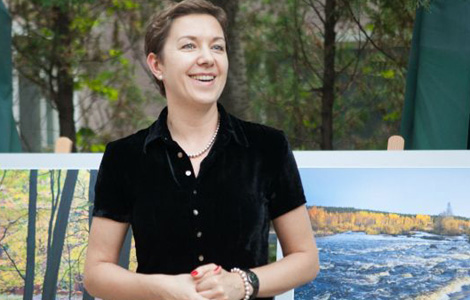
 'Taken 2' grabs movie box office crown
'Taken 2' grabs movie box office crown
 Rihanna's 'Diamonds' tops UK pop chart
Rihanna's 'Diamonds' tops UK pop chart
 Fans get look at vintage Rolling Stones
Fans get look at vintage Rolling Stones
 Celebrities attend Power of Women event
Celebrities attend Power of Women event
 Ang Lee breaks 'every rule' to make unlikely new Life of Pi film
Ang Lee breaks 'every rule' to make unlikely new Life of Pi film
 Rihanna almost thrown out of nightclub
Rihanna almost thrown out of nightclub
 'Dark Knight' wins weekend box office
'Dark Knight' wins weekend box office
 'Total Recall' stars gather in Beverly Hills
'Total Recall' stars gather in Beverly Hills
Creative cowhide
Updated: 2013-05-13 09:32
By Wang Kaihao (China Daily)
|
||||||||
 |
|
A leather painting shows running horses and the map of Inner Mongolia autonomous region. |
"Each hide is unique," Dong says. "Depending on each piece's texture, I will need to use different strength to dye the painting and let the colorants filter into the leather at the right rate."
Dong says one will only be able to comprehend the subtleness of coloring after years of practice. To provide texture to the paintings' surface, he goes through an energy-consuming carving process.
Leather paintings were popular among Mongols for centuries. They originated from martial maps during the time of Genghis Khan (1162-1227), and were later used to record scenarios of daily life. But, as it lost practical function in modern times, the aureole of this tradition faded away.
Dong recalls it was difficult to find leather paintings in Hohhot in the 1990s except some small rough pieces in souvenir shops. He was then a designer and disappointed to find some people displaying leather paintings, which were dull in color. So, he gathered a few painters with the hope of creating better leather pictures. He met with more frustrations, having to face an uninterested market.
Their paintings were usually priced at 3,000 yuan ($485) each because of the tedious work involved and the fine materials, but the price was too high for locals whose average monthly income was only in the hundreds during that time. They moved to Beijing with the hope of a more positive response, but sales remained weak. In 2003, he joined Suluding.
"When the SARS scare subsided in 2003, there was an unprecedented golden season for tourism," says 50-year-old Hohhot-native Yun Chengyi of Mongolian ethnic group, who started the studio. "Many people were introduced to Mongolian leather paintings for the first time, and it was a good chance to promote this indigenous culture."
But the road to success has been challenging.
| Ancient art given new life | Living master of thangka |
Most Viewed
Editor's Picks

|

|

|

|

|

|
Today's Top News
Shenzhou X astronaut gives lecture today
US told to reassess duties on Chinese paper
Chinese seek greater share of satellite market
Russia rejects Obama's nuke cut proposal
US immigration bill sees Senate breakthrough
Brazilian cities revoke fare hikes
Moody's warns on China's local govt debt
Air quality in major cities drops in May
US Weekly

|

|









